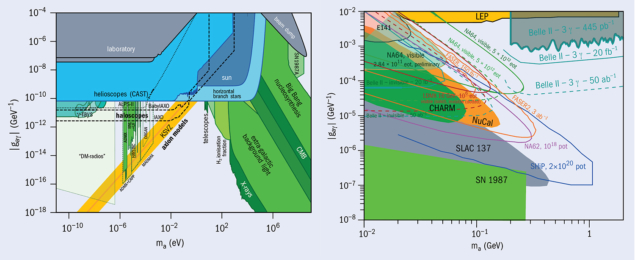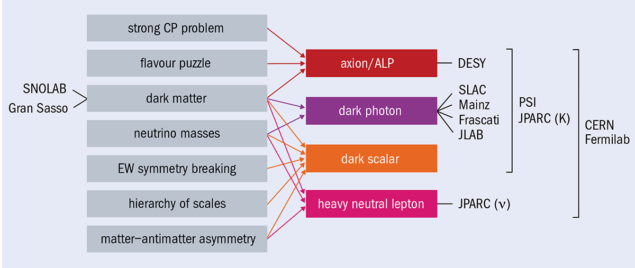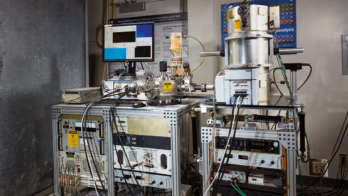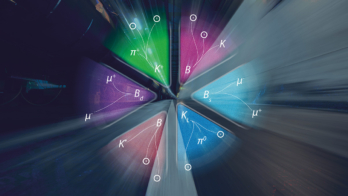
Since the discovery of the Higgs boson in 2012, great progress has been made in our understanding of the Standard Model (SM) and the prospects for the discovery of new physics beyond it. Despite excellent advances in Higgs-sector measurements, searches for WIMP dark matter and exploration of very rare processes in the flavour realm, however, no unambiguous signals of new fundamental physics have been seen. This is the reason behind the explosion of interest in feebly interacting particles (FIPs) over the past decade or so.
The inaugural FIPs 2020 workshop, hosted online by CERN from 31 August to 4 September, convened almost 200 physicists from around the world. Structured around the four “portals” that may link SM particles and fields to a rich dark sector – axions, dark photons, dark scalars and heavy neutral leptons – the workshop highlighted the synergies and complementarities among a great variety of experimental facilities, and called for close collaboration across different physics communities.
Today, conventional experimental efforts are driven by arguments based on the naturalness of the electroweak scale. They result in searches for new particles with sizeable couplings to the SM, and masses near the electroweak scale. FIPs represent an alternative paradigm to the traditional beyond-the-SM physics explored at the LHC. With masses below the electroweak scale, FIPs could belong to a rich dark sector and answer many open questions in particle physics (see “Four portals” figure). Diverse searches using proton beams (CERN and Fermilab), kaon beams (CERN and JPARC), neutrino beams (JPARC and Fermilab) and muon beams (PSI) today join more idiosyncratic experiments across the globe in a worldwide search for FIPs.
FIPs can arise from the presence of feeble couplings in the interactions of new physics with SM particles and fields. These may be due to a dimensionless coupling constant or to a “dimensionful” scale, larger than that of the process being studied, which is defined by a higher dimension operator that mediates the interaction. The smallness of these couplings can be due to the presence of an approximate symmetry that is only slightly broken, or to the presence of a large mass hierarchy between particles, as the absence of new-physics signals from direct and indirect searches seems to suggest.

Take the axion, for example. This is the particle that may be responsible for the conservation of charge–parity symmetry in strong interactions. It may also constitute a fraction or the entirety of dark matter, or explain the hierarchical masses and mixings of the SM fermions – the flavour puzzle.
Or take dark photons or dark Z′ bosons, both examples of new vector gauge bosons. Such particles are associated with extensions of the SM gauge group, and, in addition to indicating new forces beyond the four we know, could lead to evidence of dark-matter candidates with thermal origins and masses in the MeV to GeV range.
Exotic Higgs bosons could also have been responsible for cosmological inflation
Then there are exotic Higgs bosons. Light dark scalar or pseudoscalar particles related to the SM Higgs may provide novel ways of addressing the hierarchy problem, in which the Higgs mass can be stabilised dynamically via the time evolution of a so-called “relaxion” field. They could also have been responsible for cosmological inflation.
Finally, consider right-handed neutrinos, often referred to as sterile neutrinos or heavy neutral leptons, which could account for the origin of the tiny, nearly-degenerate masses of the neutrinos of the SM and their oscillations, as well as providing a mechanism for our universe’s matter–antimatter asymmetry.
Scientific diversity
No single experimental approach can cover the large parameter space of masses and couplings that FIPs models allow. The interconnections between open questions require that we construct a diverse research programme incorporating accelerator physics, dark-matter direct detection, cosmology, astrophysics, and precision atomic experiments, with a strong theoretical involvement. The breadth of searches for axions or axion-like particles (ALPs) is a good indication of the growing interest in FIPs (see “Scaling the ALPs” figure). Experimental efforts here span particle and astroparticle physics. In the coming years, helioscopes, which aim to detect solar axions by their conversion into photons (X-rays) in a strong magnetic field, will improve the sensitivity by more than 10 orders of magnitude in mass in the sub-eV range. Haloscopes, which work by converting axions into visible photons inside a resonant microwave cavity placed inside a strong magnetic field, will complement this quest by increasing the sensitivity for small couplings by six orders of magnitude (down to the theoretically motivated gold band in a mass region where the axions can be a dark-matter candidate). Accelerator-based experiments, meanwhile, can probe the strongly motivated QCD scale (MeV–GeV) and beyond for larger couplings. All these results
will be complemented by a lively theoretical activity aimed at interpreting astrophysical signals within axion and ALP models.
FIPs 2020 triggered lively discussions that will continue in the coming months via topical meetings on different subjects. Topics that motivated particular interest between communities included possible ways of comparing results from direct-detection dark-matter experiments in the MeV–GeV range against those obtained at extracted beam line and collider experiments; the connection between right-handed neutrino properties and active neutrino parameters; and the interpretation of astrophysical and cosmological bounds, which often overwhelm the interpretation of each of the four portals.
The next FIPs workshop will take place at CERN next year.





